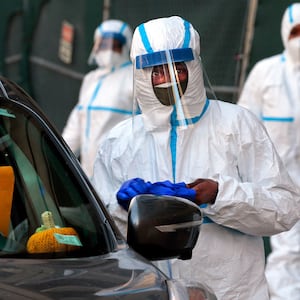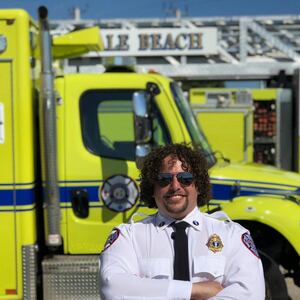For seven emergency response physicians associated with the Marcus Daly Memorial Hospital in Hamilton, Montana, the rapid spike of coronavirus cases in the state has them at their breaking point.
The 80-year-old hospital system, named after one of the three “Copper Kings” of Butte, has seen the number of total infections double in the last few weeks—and the pandemic is slated to only get worse as winter looms.
In the last week alone, three residents in Ravalli County—where the hospital is located—have died from coronavirus complications. On Tuesday, all Stevensville schools were forced to close for two weeks and pivot to remote learning after the school system couldn’t find enough staff to fill classrooms.
At least four more schools in the county had to do the same in the past fortnight—including one school in which 40 percent of the students either had COVID-19 or had been in close contact with someone who did.
“This is a real threat, and it is getting worse daily—there is no exaggeration in saying that,” the doctors said in a letter addressed to the hospital community on Tuesday. “If this trend continues, our local healthcare resources will quickly become overwhelmed; indeed, this is already starting to occur. We are on the break of disaster.”
The dire situation in Ravalli County is a microcosm for the state, which has continued to shatter COVID-19 records. As one of the earliest states to loosen coronavirus restrictions in April, Montana is now struggling to address a brewing crisis.
And while a statewide mask mandate was enacted in July, enforcement has been largely left to local leaders—many of whom lack the resources or support from their Republican constituents to do so. Montana Gov. Steve Bullock, a Democrat, rebuffed a recommendation from the White House Coronavirus Task Force, which pegged Montana as a “red-zone,” to implement fines for mask non-compliance.
“Now, we do things the Montana way here and we are not going to start encouraging the issuing of fines,” Bullock said in a September press call. “But I think the point here ought to be clear enough. We all need to do our part in wearing masks and find ways to encourage others to do the same.”
The future of the state’s response to the deadly virus is more uncertain than ever after Republican Rep. Greg Gianforte’s recent win in the gubernatorial race, bringing an end to a 16-year Democratic streak in the state. For his part, the 59-year-old entrepreneur, one of the wealthiest members of Congress, has already announced a COVID-19 task force to curtail the surge.
“Montana faces a public health crisis and economic crisis as a result of COVID-19—which I trust the people of Montana to take seriously,” Gianforte, who campaigned on personal responsibility over state mandates, said this month. “It remains my top priority to work together to protect the most vulnerable among us, while also safely and fully opening back up our economy.”
At least 472 people have died and 42,070 more have been infected with the coronavirus in Montana, the state’s health department reported on Wednesday. According to the Johns Hopkins University, the seven-day test positive rate is almost 30 percent, putting it among the top ten in the world alongside Poland, Switzerland, and the Czech Republic.
Cases have surged by 13 percent in the last two weeks, particularly in Yellowstone and Cascade counties. At that pace, the state is on track for 1,800 deaths by February if severe measures aren’t taken, according to a University of Washington projection.
The situation is so dire that the U.S Department of Health and Human Services dispatched a team of nearly 30 doctors, nurses, paramedics, and other health-care workers to Billings for two weeks to help strained health-care systems. A state report showed that several hospitals in most metropolitan cities, including Helena and Butte, are at 90 percent capacity, the Billings Gazette reported.
“There is no region in our state right now that is immune to the increasing volume of coronavirus cases,” Montana Hospital Association CEO Rich Rasmussen said, stressing that smaller hospitals rely on urban facilities for critical care. “In virtually every community, we are at capacity or near capacity.
“The challenge we have now is that virtually the entire country is under a surge,” he added. “If Marcus Daly can’t refer a patient in state, they will look out of state, but now even those out-of-state hospitals are at or near capacity.”
In Ravalli County, the pandemic is straining capacity on multiple fronts. On Wednesday, 33 residents tested positive, adding to a total of 718 active cases in the rural county of 43,000.
Stevensville Schools Superintendent Bob Moore said five COVID-19 cases last week forced too many staff into quarantine. “I had an entire classified department that had to go home on quarantine,” he said in a statement to KPAX. The district’s shutdown comes just a month after it had to close temporarily over a COVID-19 case.
Ravalli County Commissioner Chris Hoffman said the need for compliance with COVID-19 mitigation plans is “at an all-time high.”
“The concern now is COVID-19 fatigue, it’s people not being as vigilant as they have been,” Hoffman told The Daily Beast, noting that he doesn’t have the authority to make directives.
The community has done a “great job” of following the mask mandate and being respectful to one another, Hoffman said, a secret to why the small town’s infection rate is “not nearly as high as other places in the state.” But despite the neighborly hospitality, there’s a divide between residents who are “very concerned” about the pandemic and those who are not.
“I think we are on the same page as public health and the ER doctors that wrote the letter,” he said. “That letter frankly is just a better-worded version of what our stance is—we just want residents to educate themselves and make good decisions.”
In the letter, the seven Marcus Daly Memorial Hospital doctors said that, as the pandemic surges, their “ability to safely care for patients is becoming compromised.”
“We have treated patients with life-threatening illnesses such as heart attacks that we can’t appropriately transfer because of the overcapacity of all hospitals in our region,” the letter stated, noting several cases where “critically ill patients” had been transferred out of state because there was no room in the entire state. “We don’t have the bed capacity, and neither do any of our regional hospitals.”
They begged residents and other health-care workers to follow COVID-19 mitigation guidelines—including avoiding large gatherings, mask-wearing, and social guidelines.
Acknowledging that it required “real sacrifice to change one’s habits, whether it means wearing a mask when you go to the grocery store or church, or whether it means canceling a much anticipated gathering,” the doctors stressed the guidelines are meant to stop the spread to bring their community “back to normal as soon as possible.”
“As emergency physicians, but also as members of your community, as your neighbors and friends, we are pleading for your help,” the doctors stressed. “We cannot do this without you. We believe the quickest path to normalcy—and the one with fewest casualties—is to take this threat seriously today.”








